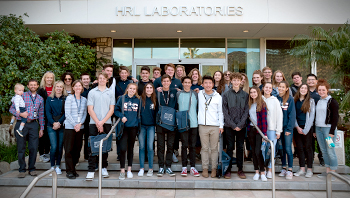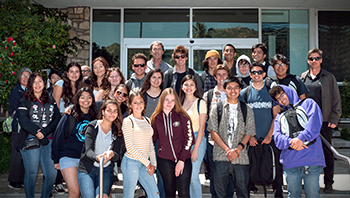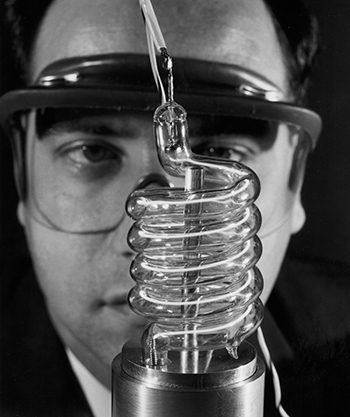YOUNG COMPANY, LONG HISTORY
HRL Laboratories continues the legacy of technology advances that began at Hughes Research Laboratories, established by Howard Hughes in 1948. HRL Laboratories was organized as a limited liability company (LLC) on December 17, 1997 and received its first patent on September 12, 2000. With over 1100 patents and counting, we're proud of our talented group of researchers, who continue the long tradition of technical excellence and innovation.
First Laser

One of Hughes' most notable achievements came in 1960 with the demonstration of the world's first laser which used a synthetic ruby crystal. The ruby laser became the basis of a multibillion-dollar laser range-finder business for Hughes. In 2010 during the 50th anniversary of the laser, HRL was designated a Physics Historic Site by the American Physical Society and was selected an IEEE Milestones location as the facility where the first working laser was demonstrated.
First Self-Aligned Gate MOSFET (SAGFET)

Attracting little fanfare at the time, a seminal invention developed at Hughes was the ion-implanted, self-aligned gate metal-oxide semiconductor (MOS) field-effect transistor, or SAGFET. Conceived by inventor Robert Bower in 1965, the device became the basis for all modern integrated circuits and has been described by the National Inventor's Hall of Fame as "the most replicated manmade structure in the history of mankind."
First Liquid Crystal Light Valve (LCLV) For Large Screen Displays

The first LCLV imaging for large screen displays was demonstrated in 1969. It has been applied to graphics projectors in commercial businesses and in large screen displays for military command and control. Today, HRL is leveraging knowledge in photonics, RF technology, and signal processing to create discriminators for future defense systems and commercial applications.
A Leader in Integrated Circuits

Custom optical fibers and integrated optical circuits pioneered at Hughes Research Labs in the early 1970s resulted in the development of high-speed integrated optical modulators, detectors and switches. We continue to pioneer new generations of circuitry, including the world's first W-Band MMIC and a world-record IC speed (150 GHz).
Pioneer in Ion Propulsion

Unique in its longevity as a development area, ion propulsion research continued at Hughes Research Labs from 1961 until it was transitioned in its prototype stage more than 30 years later. An ion propulsion engine was successfully launched on a satellite in 1997.
Artificial Intelligence

In 1984, Hughes Labs' Artificial Intelligence Center generated software for the Defense Advanced Research Projects Agency's Autonomous Land Vehicle, which demonstrated the world's first autonomous navigation of cross-country terrain. HRL remains a leader in robust computing and communications. Today, researchers are exploring new paradigms for developing complex, intelligent systems for computing, object detection, communications and networking.


